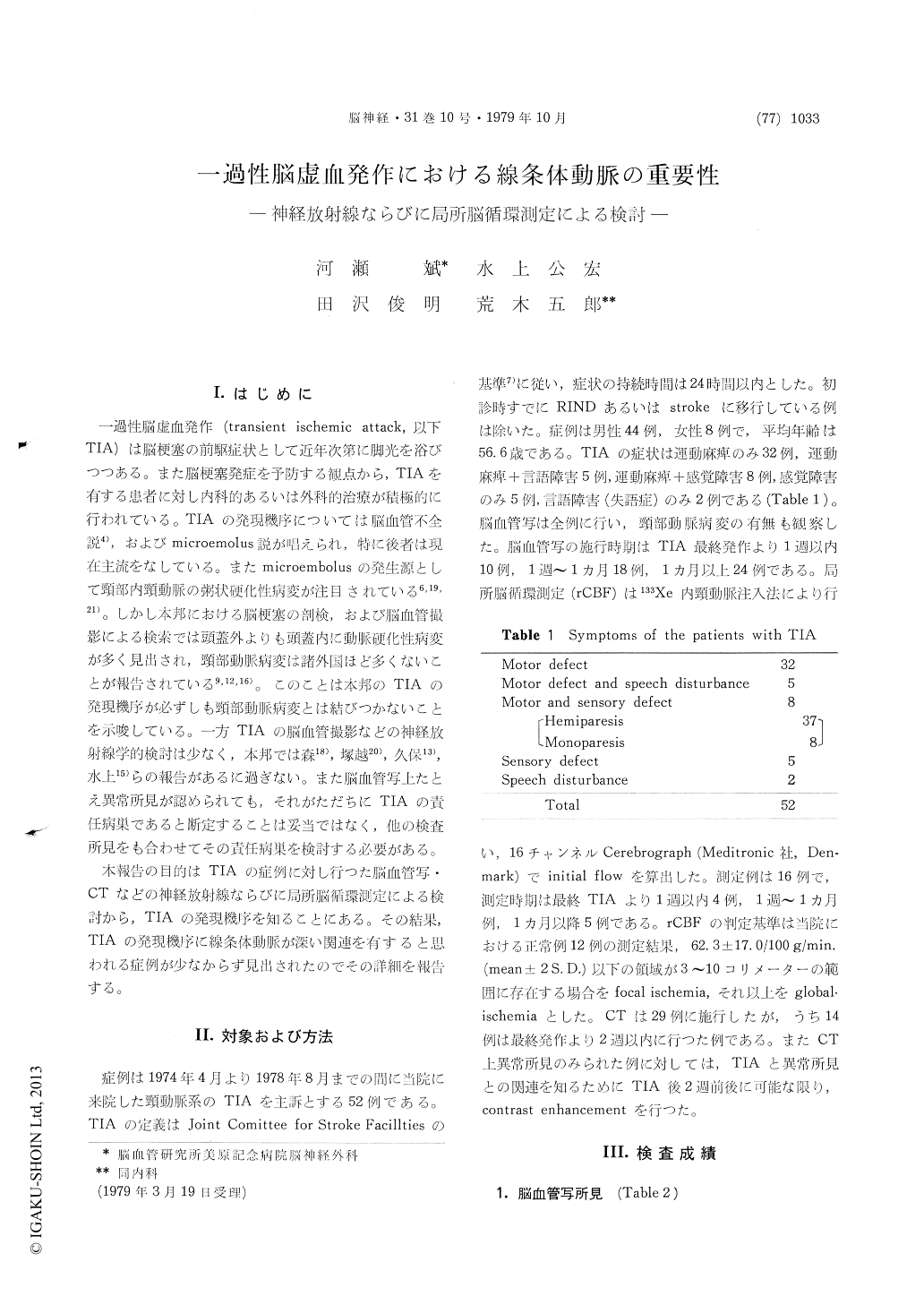Japanese
English
- 有料閲覧
- Abstract 文献概要
- 1ページ目 Look Inside
I.はじめに
一過性脳虚血発作(transient ischemic attack,以下TIA)は脳梗塞の前駆症状として近年次第に脚光を浴びつつある。また脳梗塞発症を予防する観点から,TIAを有する患者に対し内科的あるいは外科的治療が積極的に行われている。TIAの発現機序については脳血管不全説4),およびmicroemolus説が唱えられ,特に後者は現在主流をなしている。またmicroembolusの発生源として頸部内頸動脈の粥状硬化性病変が注目されている6,19,21)。しかし本邦における脳梗塞の剖検,および脳血管撮影による検索では頭蓋外よりも頭蓋内に動脈硬化性病変が多く見出され,頸部動脈病変は諸外国ほど多くないことが報告されている9,12,16)。このことは本邦のTIAの発現機序が必ずしも頸部動脈病変とは結びつかないことを示唆している。一方TIAの脳血管撮影などの神経放射線学的検討は少なく,本邦では森18),塚越20),久保13),水上15)らの報告があるに過ぎない。また脳血管写上たとえ異常所見が認められても,それがただちにTIAの責任病巣であると断定することは妥当ではなく,他の検査所見をも合わせてその責任病巣を検討する必要がある。
本報告の目的はTIAの症例に対し行つた脳血管写・CTなどの神経放射線ならびに局所脳循環測定による検討から,TIAの発現機序を知ることにある。
The aetiology of transient ischemic attack (TIA) has been well discussed, and atherosclerotic change of extracranial portion of the internal carotid artery has been described as a chief causal factor. This concept, however, cannot fully be accepted in every case of TIA, because it is well recognized that the stenotic lesion is more frequently found in intra-cranial artery than in extracranial artery in Japan. The purpose of this study is to clarify the patho-genesis of TIA, with the aid of neuroloradiogical studies, concurrently with the measurement of regional cerebral blood flow (rCBF).
Fifty-two patients with carotid TIA'(s) were investigated by angiography, and computed tomo-graphy (CT) was also performed in 29 cases. Regional CBF was measured in 16 cases.
About two third of the patients has the stenotic lesion (s) on angiograms. The incidence of the lesion is greater (double) in intracranial arteries than in extracranial artery. Of twenty-four intra-cranial stenotic lesions, thirteen (54%) were found in horizontal portion of the middle cerebral artery (M1). Regional CBF was slightly reduced in five of seven patients with severe arterial stenosis, while rCBF was normal in most (eight of nine)patients with mild arterial stenosis or without stenosis. An abnormal CT finding was found in nine of 29 patients ; namely, eight had a small low density area in the basal ganglia near the internal capsule, and one had a low density area in temporal lobe. In three of nine patients with small low density area in the basal ganglia, the lesion was enhanced after contrast infusion about two weeks after TIA. This indicates that the enhanced area seems to contribute to TIA. Of eight patients with small low density area in the basal ganglia on CT, five (63%) had a mild or severe stenosis of M1, and the incidence of Mi stenosis was signifi-cantly higher than that of the patients with normal CT (20%). None of them had a stenotic lesion in cervical internal carotid artery. These findings strongly suggest that the cause of TIA in patients with low density area in the basal ganglia is due to ischemia of the distribution of lenticulostriate artery. An atheromatous change of M1 or lenti-culostriate artery itself may cause blood flow dis-turbance near the internal capsule.
We would like to stress that blood flow dis-turbance of lenticulostriate artery is a chief causal factor of TIA, in the patients with normal finding or mild stenosis of M1 on angiogram.

Copyright © 1979, Igaku-Shoin Ltd. All rights reserved.


